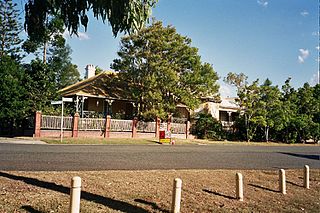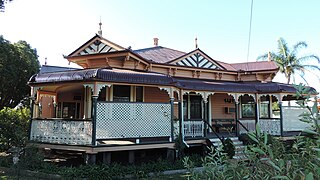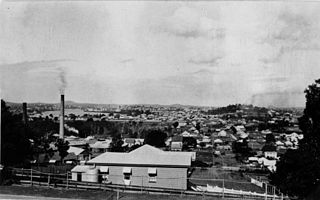
Clifford House is a heritage-listed club house at 120 Russell Street, Toowoomba, Toowoomba Region, Queensland, Australia. It was built c. 1865. It was added to the Queensland Heritage Register on 21 October 1992.

Windermere is a heritage-listed villa at 14 Sutherland Avenue, Ascot, Queensland, Australia. It was built from c. 1886 to 1930s. It was added to the Queensland Heritage Register on 21 October 1992.

John Mills' residence is a heritage-listed villa at 107 Kadumba Street, Yeronga, City of Brisbane, Queensland, Australia. It was built c. 1914/1915. It was added to the Queensland Heritage Register on 25 August 2000.

Como is a heritage-listed villa at 88 Kadumba Street, Yeronga, City of Brisbane, Queensland, Australia. It was designed by Alexander Brown Wilson and built from 1889 to 1890 by Mr Peterson. It is also known as Barrogill. It was added to the Queensland Heritage Register on 25 August 2000.

Astolat is a heritage-listed villa at 96 Kadumba Street, Yeronga, City of Brisbane, Queensland, Australia. It was built from c. 1890 to c. 1890. It was added to the Queensland Heritage Register on 25 August 2000.

Teneriffe House is a heritage-listed villa at 37 Teneriffe Drive, Teneriffe, City of Brisbane, Queensland, Australia. It was designed by William Henry Ellerker and built in 1865. It was added to the Queensland Heritage Register on 14 May 1993.

Bulimba House is a heritage-listed detached house at 34 Kenbury Street, Bulimba, Queensland, Australia. It was designed and built by Andrew Petrie from 1849 to 1850. It is also known as Toogoolawah. It was added to the Queensland Heritage Register on 21 October 1992.

Astrea is a heritage-listed duplex (building) at 19 Bank Street, West End, Queensland, Australia. It was built c. 1888 for Fedder Jensen. It was added to the Queensland Heritage Register on 21 October 1992.

Collins Place is a heritage-listed detached house at 271 Grey Street, South Brisbane, Queensland, Australia. It was built c. 1889. It is also known as Greyscourt and Byanda. It was added to the Queensland Heritage Register on 21 October 1992.

Coronation Hotel is a heritage-listed hotel at 46 Montague Road, South Brisbane, Queensland, Australia. It was designed by Francis Drummond Greville Stanley and built in 1891. It is also known as Montague Hotel. It was added to the Queensland Heritage Register on 30 April 1993.

Woolloongaba Post Office is a heritage-listed former post office at 765 Stanley Street, Woolloongabba, City of Brisbane, Queensland, Australia. It was designed by Thomas Pye and built in 1905 by Thomas Rees. It is also known as Woolloongabba Post & Telegraph Office. It was added to the Queensland Heritage Register on 24 January 2003.

Sandgate Post Office is a heritage-listed former post office at 1 Bowser Parade, Sandgate, City of Brisbane, Queensland, Australia. It was designed in the office of the Queensland Colonial Architect and built from 1886 to 1887. It is also known as Sandgate Post and Telegraph Office. It was added to the Queensland Heritage Register on 7 February 2005.

Saltwood is a heritage-listed holiday home at 154 Shorncliffe Parade, Shorncliffe, City of Brisbane, Queensland, Australia. It was built from 1870s to 1930s circa. It was added to the Queensland Heritage Register on 9 July 1993.

Craigellachie is a heritage-listed detached house at 10 Fosbery Street, Windsor, City of Brisbane, Queensland, Australia. It was built c. 1889 by its owner John Grant, a stonemason. It was added to the Queensland Heritage Register on 21 October 1992.

Stanley Hall is a heritage-listed former residence at 25 Enderley Road, Clayfield, City of Brisbane, Queensland, Australia. It was first built in 1885 and redeveloped c. 1890 to a design by architect George Henry Male Addison. It is now part of St Rita's College. It was added to the Queensland Heritage Register on 21 October 1992.

Bryntirion is a heritage-listed detached house at 287 Wickham Terrace, Spring Hill, City of Brisbane, Queensland, Australia. It was designed by James Furnival for Edward Barton Southerden and built in 1861 with subsequent extensions. It was added to the Queensland Heritage Register on 17 December 1993.

William Grigor's House is a heritage-listed semi-detached house at 19 Gloucester Street, Spring Hill, City of Brisbane, Queensland, Australia. It was built in the late 1860s. It was added to the Queensland Heritage Register on 30 July 1993.

Aberfoyle is a heritage-listed detached house at 35 Wood Street, Warwick, Southern Downs Region, Queensland, Australia. It was designed by architect Hugh Hamilton Campbell and built from 1910 to c. 1927. It was added to the Queensland Heritage Register on 5 August 1996. It is also listed on the Southern Downs Local Heritage Register.

Ulster Hotel is a heritage-listed hotel at 25 Brisbane Street, Ipswich, City of Ipswich, Queensland, Australia. It was built in 1910. It was added to the Queensland Heritage Register on 21 October 1992.

The Maryborough Customs House is a heritage-listed former customs house at Richmond Street, Maryborough, Fraser Coast Region, Queensland, Australia. It was designed by John Smith Murdoch and built in 1899. It was added to the Queensland Heritage Register on 7 February 2005.
































